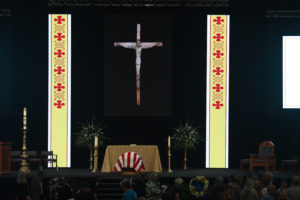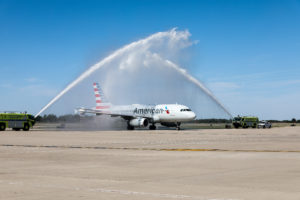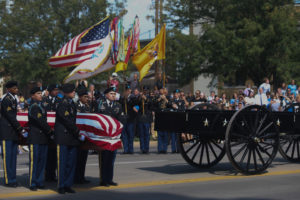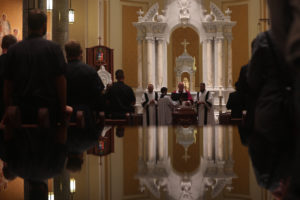WICHITA, Ks. — Chaplain (Capt.) Emil J. Kapaun was captured by enemy forces on Nov. 2, 1950 when he volunteered to stay behind to care for wounded Soldiers.
On Sept. 25, 2021, he finally returned home. This past week, leaders from 1st Cavalry Division travelled to Kansas to give Chaplain Kapaun a hero’s welcome along with thousands of others as the chaplain’s remains were carried onto US. soil.
“Chaplain Kapaun’s remains remained in North Korea and Hawaii for 70 years, “said Maj. Gen. John Richardson, commanding general, 1st Cavalry Division. “Today and this week was symbolic, and the division will never forget our fallen comrade,”
Kapaun was posthumously awarded the Medal of Honor on April 11, 2013 by President Barak Obama for his actions during the Korean War. Eight years later, the Defense POW/MIA Accounting announced that Kapaun’s remains had been positively identified after being previously interred at the National Memorial Cemetery of the Pacific in Honolulu, Hawaii, in a grave marked as unknown.
Chaplain Kapaun was born in Pilsen, Kansas. He left his hometown on Dec. 16, 1949, to serve with the post-World War II peacekeeping forces. He first arrived in Yokohama, Japan where he joined the 1st Cavalry Division and was later assigned to 3rd Battalion, 8th Cavalry Regiment in June 1950.
Shortly after his arrival Japan, North Korea fighters invaded South Korea and Soldiers from the 1st Cavalry Division were amongst the first to assist.
As the 8th Cav fought through North Korea, Chaplain Kapaun continued his duties by tending to the Soldiers’ welfare and spiritual needs. He also risked his own life to render medical aid, pray with the wounded and bury the dead.
“He was a chaplain, but he was a leader chaplain.” Richardson said. “He put his Soldiers before himself. He put his fellow men before himself and that inspired those around him. That inspiration is what helps a unit make it through the tough times.
“That is something we can all walk away with, the idea that your personal presence and inspiring people through your presence is a powerful leadership lesson,” Richardson added.
As the 3-8 CAV drew closer to the Chinese border, they were oblivious to the 125,000 Chinese fighters already in the country and encircling their location.
“An enemy infiltration overran 3-8 CAV’s command post,” said Lt. Col. Nicholas Sinclair, commander, the current 3-8 CAV commander. As command and control broke down across the battlefield, Kapaun helped rescue more than 30 wounded Soldiers and ministered to countless others.”
Chaplain Kapaun stayed back to care for wounded Soldiers and let himself get captured knowing well that he would become a prisoner of war.
The Code of Conduct did not exist until after the Korean War. The experience of Kapaun and other POWs helped shape the current policy.
“The 1st Cavalry Division owes a debt of gratitude to Chaplain Kapaun and his family,” said Command Sgt .Maj. Shade Munday, command sergeant major, 1st Cavalry Division. “We are thankful to have him back home after 70 years. His heroism and sacrifice for our country will never be forgotten.
“1st Cavalry Division will continue to highlight his legacy and honor his memory as a Cav Trooper. The Kapaun family has our continued support and our eternal gratitude,” Munday added.
Chaplain Kapaun died as POW on May 23, 1951 after falling ill and forced to isolated from other captives. POWs who remember Kapaun credit their survival to the chaplain, who would often sneak out of camp and risk his own life to get them extra food.
“Chaplain Kapaun provided spiritual resistance that was absolutely necessary in the prisoner of war camp, by doing so he made himself a target.” Sinclair said. “The Chinese saw what kind of influence he was within the camp and because of his actions he was held in solitary confinement.”
For more than 70 years Chaplain Kapaun’s remains were unidentified, as many Soldiers still are to this day. But on Sep. 25, hundreds of people watched form the windows and flight line of Wichita Dwight D. Eisenhower National Airport as an American Airlines flight landed with Kapaun’s remains. He was accompanied by his family from Hawaii, who long awaited his return.
That same day a motorcade carrying Chaplain Kapaun’s remains traveled to a the small town of Pilsen, Kansas, Kapaun’s hometown. The road leading to his home parish, St. John Nepomucene Catholic Church, was lined by veterans and locals with American flags to welcome him home.
The 1st Cavalry Division was also there to honor Chaplain Kapaun both as a beloved priest in the community and as an American hero. Several events were planned for the community to visit Chaplain Kapaun’s remains from Sept. 25–29, to include a vigil and Mass that thousands attended just outside Wichita, Kansas
Then on Sept. 29, thousands of friends and followers lined the streets of downtown Wichita as Chaplain Kapaun’s remains were escorted by horse-drawn caisson to his final resting place.
“It’s absolutely powerful to me as a member of 3rd Battalion, 8th Cavalry Regiment, that we are able to be here in person and honor him with our color guard,” Sinclair said.
His remains will remain entombed at the Cathedral of the Immaculate Conception where the community can come visit him.
“I draw strength and determination form those who came before us and I don’t think you can draw much more strength than from Chaplain Kapaun,” said Richardson. “He was a role model for all of us, an inspiration.”
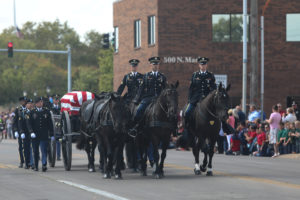
(Photos by U.S. Army Master Sgt. Miriam Espinoza)
